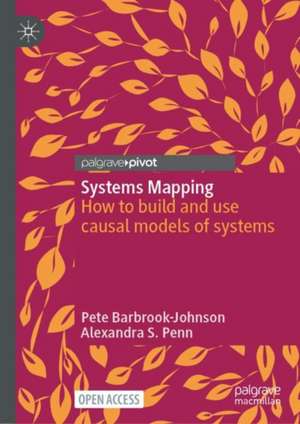Systems Mapping: How to build and use causal models of systems
Autor Pete Barbrook-Johnson, Alexandra S. Pennen Limba Engleză Hardback – iul 2022
This open access book explores a range of new and older systems mapping methods focused on representing causal relationships in systems. In a practical manner, it describes the methods and considers the differences between them; describes how to use them yourself; describes how to choose between and combine them; considers the role of data, evidence, and stakeholder opinion; and describes how they can be useful in a range of policy and research settings. This book provides a key starting point and general-purpose resource for understanding complex adaptive systems in practical, actionable, and participatory ways. The book successfully meets the growing need in a range of social, environmental, and policy challenges for a richer more nuanced, yet actionable and participatory understanding of the world. The authors provide a clear framework to alleviate any confusion about the use of appropriate terms and methods, enhance the appreciation of the value they can bring, and clearly explain the differences between approaches and the resulting outputs of mapping processes and analysis.
Preț: 358.81 lei
Nou
Puncte Express: 538
Preț estimativ în valută:
68.66€ • 71.25$ • 57.39£
68.66€ • 71.25$ • 57.39£
Carte disponibilă
Livrare economică 25 februarie-11 martie
Livrare express 08-14 februarie pentru 32.77 lei
Preluare comenzi: 021 569.72.76
Specificații
ISBN-13: 9783031018336
ISBN-10: 3031018338
Pagini: 186
Ilustrații: XVII, 186 p. 22 illus., 13 illus. in color.
Dimensiuni: 148 x 210 x 18 mm
Greutate: 0.4 kg
Ediția:1st ed. 2022
Editura: Springer International Publishing
Colecția Palgrave Macmillan
Locul publicării:Cham, Switzerland
ISBN-10: 3031018338
Pagini: 186
Ilustrații: XVII, 186 p. 22 illus., 13 illus. in color.
Dimensiuni: 148 x 210 x 18 mm
Greutate: 0.4 kg
Ediția:1st ed. 2022
Editura: Springer International Publishing
Colecția Palgrave Macmillan
Locul publicării:Cham, Switzerland
Cuprins
Chapter 1: Introduction
Chapter 2: Rich Pictures
Chapter 3:Theory of Change diagrams
Chapter 4: Causal Loop Diagrams
Chapter 5: Participatory Systems Mapping
Chapter 6: Fuzzy Cognitive Mapping
Chapter 7: Bayesian Belief Networks
Chapter 8: System Dynamics
Chapter 9: What data and evidence can you build system maps from?
Chapter 10: Running systems mapping workshops
Chapter 11: Comparing, choosing, and combining systems mapping methods
Chapter 12: Conclusion.
Notă biografică
Pete Barbrook-Johnson is a social scientist and complexity scientist working on a range of environmental and energy policy topics, using systems mapping, agent-based modelling, and other related approaches. He is a Departmental Research Lecturer at the University of Oxford and a member of the Centre for the Evaluation of Complexity Across the Nexus (CECAN).
Alexandra S. Penn is a complexity scientist working on combining participatory methodologies and mathematical models to create tools for stakeholders to understand and ‘steer’ their complex human ecosystems. She is a Senior Research Fellow at the University of Surrey and a member of the Centre for the Evaluation of Complexity Across the Nexus (CECAN).
Textul de pe ultima copertă
This open access book explores a range of new and older systems mapping methods focused on representing causal relationships in systems. In a practical manner, it describes the methods and considers the differences between them; describes how to use them yourself; describes how to choose between and combine them; considers the role of data, evidence, and stakeholder opinion; and describes how they can be useful in a range of policy and research settings. This book provides a key starting point and general-purpose resource for understanding complex adaptive systems in practical, actionable, and participatory ways. The book successfully meets the growing need in a range of social, environmental, and policy challenges for a richer more nuanced, yet actionable and participatory understanding of the world. The authors provide a clear framework to alleviate any confusion about the use of appropriate terms and methods, enhance the appreciation of the value they can bring, and clearly explain the differences between approaches and the resulting outputs of mapping processes and analysis.
Caracteristici
Provides a practical and in-depth discussion of causal systems mapping methods
Provides guidance on running systems mapping workshops and using different types of data and evidence
Orientates readers to the systems mapping landscape and explores how we can compare, choose, and combine methods
This book is open access, which means that you have free and unlimited access
Provides guidance on running systems mapping workshops and using different types of data and evidence
Orientates readers to the systems mapping landscape and explores how we can compare, choose, and combine methods
This book is open access, which means that you have free and unlimited access
